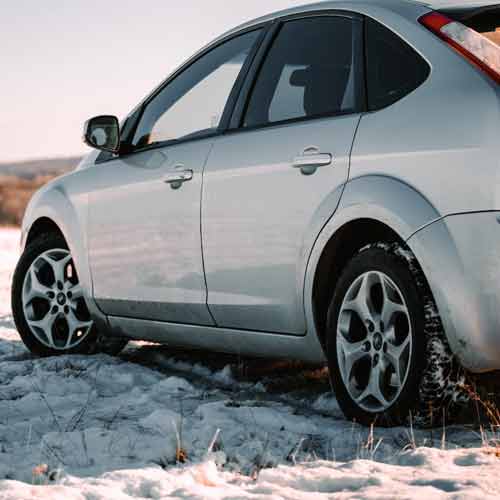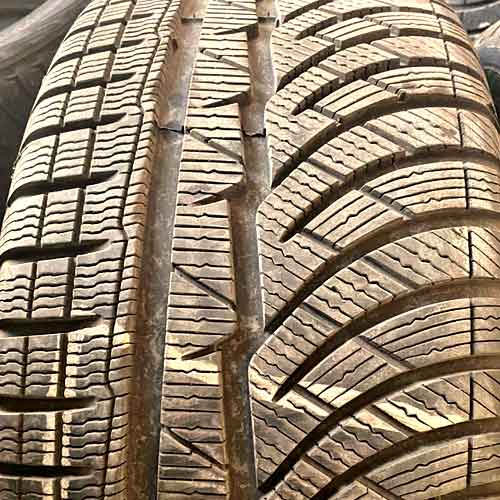The Michelin Pilot Alpin PA4 is a pretty reliable winter tire, which is not replaced by PA5. Now, although the Pilot Alpin series is a little pricey, it justifies that with it’s long lasting and fuel efficient design. Let’s see if this tire is made for you.

Compare both PA4 and PA5 in detail here: https://snowytires.com/michelin-pilot-alpin-pa4-vs-5/
Table of Contents
Key Takeaway
So overall, the Michelin Pilot Alpin PA4 tire exhibits exceptional performance, where it leads in:
- Ice Performance: Leading the way with excellent acceleration, braking, and traction on icy surfaces.
- Wet Grip and Handling: Outperforming competitors with outstanding wet grip and handling, even surpassing tires marketed for their wet performance.
- Linear Grip: Impressive grip and speed ratings, making it suitable for sporty driving in winter conditions.
- Dry Handling: Demonstrating above-average lateral traction and superb steering responsiveness.
- Tread Longevity: Above-average tread longevity with a treadwear warranty for peace of mind.
- Fuel Economy: Achieving Michelin’s Green X certification for fuel efficiency and reduced carbon emissions.
Though the tire has some drawbacks too, when it comes to following two:
- Snow Traction: Although offering effective snow contact, it could enhance snow handling for even better results.
- Resistance to Hydroplaning: The tire’s continuous running shoulders and central rib result in average float speeds, leaving room for improvement.
Info on Sizes: The Michelin Pilot Alpin PA4 comes in 51 total sizes in 17 to 21 inches. These sizes have speed ratings of H, V and W, while load ratings are standard (XL and SL). Moreover, all sizes have tread depth of 10.5/32″ and come with weight ranging from 20 to 36 lbs. Tire also offers 30k miles treadwear warranty.
Tread Appearance
The Michelin Pilot Alpin PA4 showcases an asymmetrical tread design, featuring four main ribs.

The (almost) central-most rib is continuous running, with one side being pretty smooth and straight, while the other side is serrated with sharp edges and notches.
This rib incorporates numerous sipes and slanted slits.
Adjacent to this rib are technically shoulder ribs, forming two circumferential grooves.
One of these ribs, located towards the serrated side of the central rib, covers a significant portion of the tread area.
It has chamfered outer edges and a combination of rectilinear and interlocking siping at various angles. Additionally, there are curving in-groove notches running parallel to the lateral tread voids that separate these blocks.
On the other side of the tire, you’ll find a denser arrangement of in-groove notches and longitudinal slits that don’t split up the lugs.
Meaning this rib is also continuous running, and is more longitudinally aligned, in terms of biters. Though that doesn’t go for the wave-like siping you see there, and thick in-groove notches.
Wet Performance
On a rainy day, roads can become glossy and slippery, so tires need to navigate these wet roads with precision, where their tread patterns and the type of rubber they’re made from play a big role.
These basically define the tire’s overall grip/handling and resistance to hydroplaning.
Wet Grip and Handling
Now the wet traction comes from two main factor. Tire’s ability to clear off water from its tread, and it’s gripping elements, including rubber composition.
Basically grooves and sipes clear off water (where sipes literally suck up water particles), and biters/rubber come in later, forming a water-free contact with the road, providing traction.
Now, in this regard, the Michelin Pilot Alpin PA4 is one of the best tires you can get, outperforming all its direct competitors, and by a large margin too.
To give you an idea, it outranks the Continental VikingContact 7 (a tire marketed for its superb wet performance), by over half a feet in braking (distance test).
(While handling on both tires is literally the same, referring to their compared lap times on average).
Review that tire here: https://snowytires.com/continental-vikingcontact-7-review/
Resistance to Hydroplaning
Have you ever seen a car almost glide or skim on water? That’s hydroplaning.
To avoid this, tires are designed with grooves that act like water channels, directing water away and keeping the tire firmly on the road.
Now the thing is, hydro or aquaplaning directly influences overall wet traction, as sipes would have less water burden, if more goes out through grooves.
That’s why the Pilot Alpin PA4 could have been even better in overall wet performance, if it weren’t for it’s continuous running shoulders and central rib, hindering it’s lateral water evacuation.
Meaning, the Michelin’s tire here only offers average results here, as seen by its float speeds.
Though this advantages the tire in terms of noise comfort.
Overall Winter Performance
When you think of winter tires, picture a landscape covered in ice and snow. Now, how efficiently a tire moves over these both landscape types, determines its overall winter performance.
So its best, we split this section in those two.
Ice Performance
On ice, every step can be treacherous, as tires need to hold their ground here. And they mostly do that with the help of special polymers in their compounds combined with a ton of biters.
That’s why top tier tires here have a lot of tiny grippers, which also stay flexible and responsive at all times (I mean even during harsh maneuvers and temperatures).
Now, the Michelin Pilot Alpin PA4 is leading its way literally, compared to its direct competitors, as it offers excellent acceleration values (going from 0 to 30 mph, fastest).
Moreover, the tire also offers just as great braking, and overall traction values, thanks to its superior cornering responsiveness and appreciable on-center feel.
Snow Traction
This landscape includes powdery, soft, salt-like snow (covered roads), where the tire’s job is to sink into the ground, holding onto snow particles (forming snow-to-snow contact), while letting go the excess, so they don’t accumulate and become a hindrance.
But why this contact is important here? Well, its because snowflakes stick well to others on the ground (as they have interlocking fingers). So those captured in the tire’s tread, create a bond that’s stronger than if it was just rubber touching snow.
Having said that, the Michelin Pilot Alpin PA4 offers effective contact path here, allowing for above average results overall.
The tire although lacks a little in terms of snow handling, it still offers above average results in terms of snow acceleration and braking.
Tread Noise Comfort
Noise is generated by a lot of variables and factors, but air is the biggest contributor here still.
When air rushes into the gaps in a tire’s tread, it can create a hum or buzz. Generally, the bigger these gaps, the louder the noise. It’s like the difference between blowing over the top of a wide vs. narrow bottle.
Moreover, the impact of these air particles (mainly entering through shoulders) hitting the tread, further generates additional noise and in-groove resonances.
Now the Michelin PA4 comes in the list of top quietest winter tires, with such closed up shoulders, which restrict air entry in the first place, limiting noise at the source.
Bumps Comfort
Tires act like cushions. When the car moves over bumps or potholes, the tire’s design and materials help soften those jolts, giving passengers a smoother ride.
Now the Pilot Alpin 4 having such thermally adaptive rubber, featuring Helio Compound (as Michelin likes to call it), offers great absorption to the road vibrations.
This compound basically has a lot of silica in it, which primarily offers wet traction, also helps in the overall ride comfort performance too.
Tread Longevity
Everyone wants tires that last.
And how long a tire lasts is a dance between its design resistance and the depth of its tread. I mean, although deeper treads often mean a longer-lasting tire, they can also be a bit more resistant, producing more heat.
Now, the Michelin Pilot Alpin 4 offers a good balance here, where it’s slightly above average (relatively), tread depth of 10.5/32″ takes a good enough time to reach down to 2/32″ (which is the legal tread-depth-limit allowed in the US).
So you get above average tread longevity, especially when you consider that even all sizes, (even those with speed ratings of W), have 30k miles treadwear warranty.
Dry Performance
Even in winter, there are clear days. And on these days, the tire’s ability to stick to dry roads becomes crucial. This involves how much of the tire’s rubber touches the ground and how it responds to turns and stops.
Let’s check both of these performance metrics.
Linear Grip
Imagine a car speeding down a straight road. What do you think will measure the grip there? Well, of course here the acceleration and braking matters (both being directional metrics).
Now, the Michelin Pilot Alpin PA4 does pretty well here, and it makes sense why the tire is certified by sports cars’ manufacturers, like Porsche and Audi.
I mean it’s much better on wet roads than it’s on dry, it’s still pretty impressive, I mean for a winter tire, offering tremendous grip and speed ratings up to W.
To give you a rough idea about its performance, the PA4 only lacks by a mere 3 feet in overall braking (from 60 to 0 mph), when compared to a reference summer tire (with above average dry scores).
Dry Handling
When a car turns, the edges or shoulders of the tires play a big role, determining how securely the car handles the turn.
That’s because most of the weight on the tire shifts there.
Now just like the directional grip, the Michelin PA4 also offers pretty nice results in the overall handling too, offering above average lateral traction and superb/direct steering.
The result: You get only a mere 2 second lacking handling (lap times, on average), compared to reference summer tire (with above average dry handling efficacy).
Fuel Economy
A lot of factors are at play when it comes to economy, though weight and tread compound are the most important ones.
Heavier tires or those with balder relative treads consume more energy when turning or accelerating/braking. It’s like wearing heavy boots and trying to run. What would happen? Well, you’d use more energy than if you were wearing light sneakers.
Now, the Pilot Alpin 4 is one of the most fuel efficient tires out there. That’s why it’s branded with Michelin’s Green X certification.
Tires with this label are designed to be more energy-efficient, resulting in reduced fuel consumption and lower carbon dioxide (CO2) emissions.
To Summarize
In summary, the Michelin Pilot Alpin PA4 is an exceptional winter tire that excels in various performance categories.
When it comes to ice performance, this tire leads the pack with excellent acceleration, braking, and overall traction, and although it performs admirably in snow as well, its handling capabilities could be improved slightly.
Though for wet roads, the tire’s a king, outperforming nearly all its competitors, even some pretty great ones, like the Continental VikingContact and WinterContact.
However, its resistance to hydroplaning could be better, resulting in average float speeds.
In terms of comfort, this tire shines with low tread noise and excellent bump absorption, providing a smooth and quiet ride.
And on dry, you get impressive linear grip and dry handling capabilities, making it suitable for sporty driving.
Moreover, the tire’s tread longevity is also impressive, especially when you consider it’s speed rating (going up to W), and same goes for its fuel economy, where the tire earns Michelin’s Green X certification.